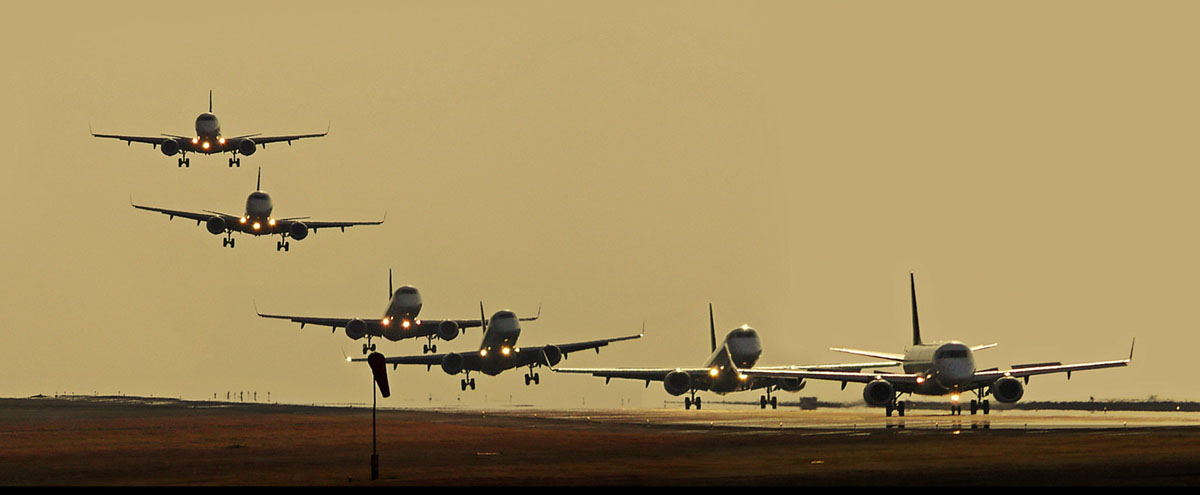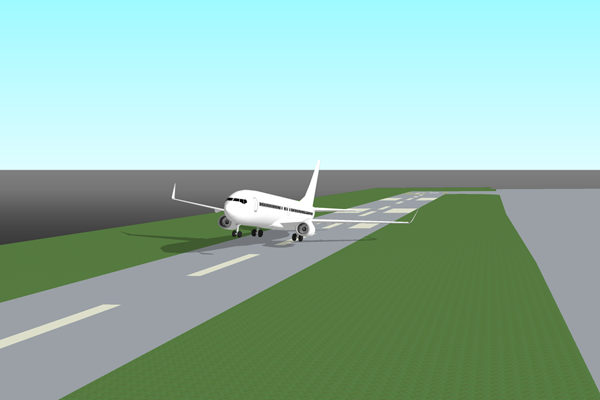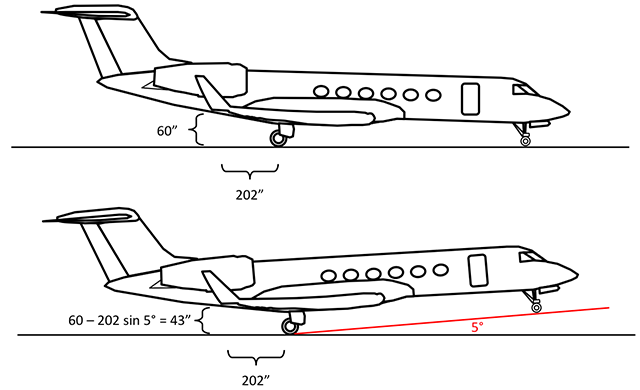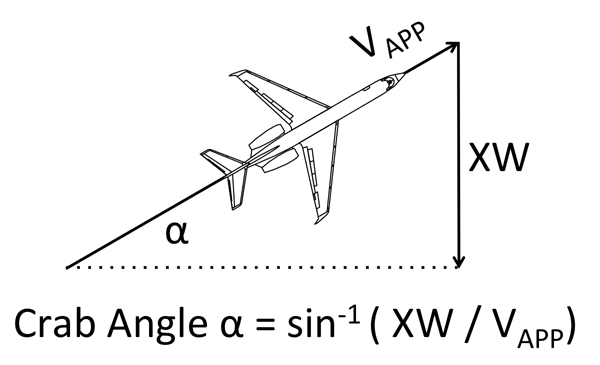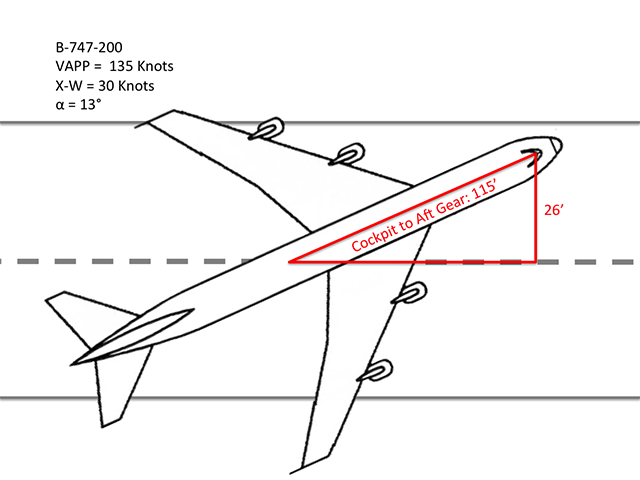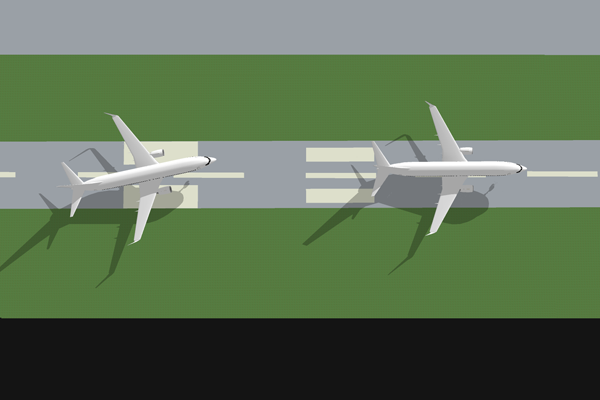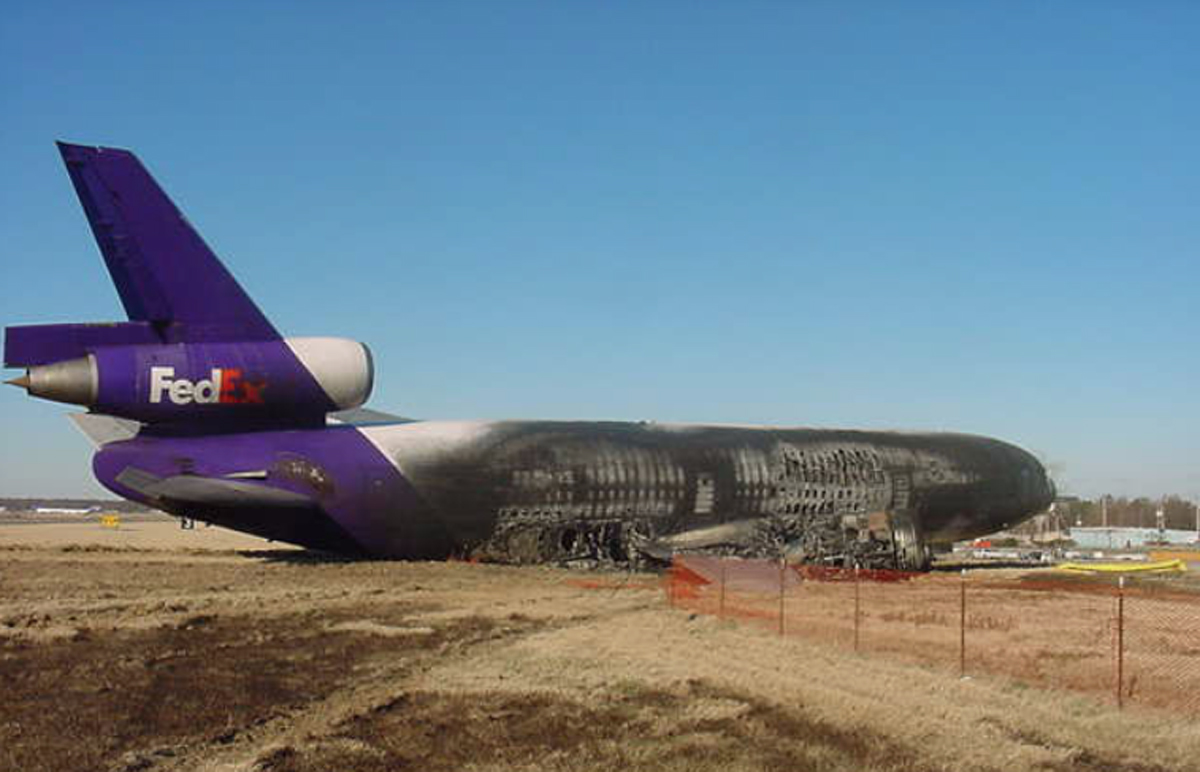As pilots we learn to deal with crosswind landings from day one. Chances are this was in a primary flight trainer that weighed less than your car and was accomplished with what some call the "wing low" method, something more properly called a sideslip. This could very well be a valid technique for the jet you are flying now, but it may not be. You might be better off landing in a "crab" or using a combination of the two methods, called a "decrab."
— James Albright

Updated:
2022-06-24
Regardless of method, a common goal is to have the airplane aligned with the runway following touchdown. Each method has its advantages and disadvantages. If your aircraft is allowed more than one method, you should know the pros and cons of each. If your aircraft manufacturer specifies a particular method, you should use that method and understand its limitations. I've flown aircraft that require landing in a crab (T-38), mandate landing only with the sideslip (B-707, T-37), allow you to use any method with limitations placed on the sideslip (B-747), or require a decrab just prior to touchdown (CL-604, GIII, GIV, GV, G450).
What follows comes from the references listed below, with my comments and techniques. I don't think anyone explains the techniques better than Boeing, and most late model Boeings allow all three methods with a few limitations. I've used the Boeing 737 NG Flight Crew Training Manual to introduce each technique as a starting point, with other aircraft offered for another point of view. If your manuals are silent or sparse when discussing cross wind landings, perhaps what follows can fill in the gaps.

1
Touchdown in a sideslip
The following 737 technique can be found in other Boeing manuals and may not apply, word-for-word, to other aircraft that allow touchdown in a sideslip. But if your manual doesn't offer any advice at all, or if you are looking for how "the big boys" do it, it gives you more information than you had.
Boeing 737 NG
- The sideslip crosswind technique aligns the airplane with the extended runway centerline so that main gear touchdown occurs on the runway centerline.
- The initial phase of the approach to landing is flown using the crab method to correct for drift. Prior to the flare the airplane centerline is aligned on or parallel to the runway centerline. Downwind rudder is used to align the longitudinal axis to the desired track as aileron is used to lower the wing into the wind to prevent drift. A steady sideslip is established with opposite rudder and low wing into the wind to hold desired course.
- Touchdown is accomplished with the upwind wheels touching just before the downwind wheels. Overcontrolling the roll axis must be avoided because overbanking could cause the engine nacelle or outboard wing flap to contact the runway.
- Properly coordinated, this maneuver results in nearly fixed rudder and aileron control positions during the final phase of the approach, touchdown, and beginning of the landing roll. However, since turbulence is often associated with crosswinds, it is often difficult to maintain the cross control coordination through the final phase of approach to touchdown.
- If the crew elects to fly the sideslip to touchdown, it may be necessary to add a crab during strong crosswinds. Main gear touchdown is made with the upwind wing low and crab angle applied. As the upwind wing touches first, a slight increase in downwind rudder is applied to align the airplane with the runway centerline. At touchdown, increased application of upwind aileron should be applied to maintain wings level.
Source: Boeing 737 NG (TM), page 6.46
Sideslip only (zero crab) landings are not recommended with crosswind components in excess of 26 knots. This recommendation ensures adequate ground clearance and is based on maintaining adequate control margin.
Source: Boeing 737 NG (TM), page 6.45
The sideslip technique tends to be restricted to aircraft with short, unswept wings . . .
Pilatus PC-12
It is recommended to use the wing down technique. At approximately 100 to 200 ft on approach to the runway, apply rudder to align the longitudinal axis of the aircraft to the runway and put on bank in the opposite direction to maintain the runway centerline. The aircraft is the flown in a sideslip to touch down initially on one wheel. As soon as one wheel touches, lower the other two to the runway and immediately select either the condition lever to ground or the PCL to beta or reverse.
Source: Pilatus POH, page 10-1
The Air Force Boeing 747-200 that I flew (E-4B) allowed touchdown in a sideslip and no crab angle up to 25 knots of crosswind. As crab angle is increased, the crosswind limit went up to 40 knots and higher. Why the limit? We were told we could actually hit the runway with an engine pod. Because of the swept wing, the chances of dragging an engine nacelle went up as the speed went down. Many business jets have highly swept wings that put the wing tips at risk, especially at high deck angles . . .
Sideslip limits
Looking at your aircraft in a three point attitude may lead you to believe it will take a lot of bank to get the wing tip in a sideslip landing. If you have a swept wing, the look of things can be deceiving. In a GV, for example, the wing tip is actually lowered 17" when the nose is raised to a normal flare attitude.
More about this: Flight Math / Wing Tip Hit Bank Angle on Landing.
In a 3-point attitude, if you were able to push the aircraft over on a wheel, the wing would contact the ground at 7° of bank:
In a normal landing attitude, the wing tip is lower to the ground and you would hit with only 5° of bank:
Note that with any yaw into the lower wing, the wing tip strike would happen even sooner.
2
Touchdown in a crab
The following 737 technique can be found in other Boeing manuals and may not apply, word-for-word, to other aircraft that allow touchdown in a crab. But if your manual doesn't offer any advice at all, or if you are looking for how "the big boys" do it, it gives you more information than you had.
Boeing 737 NG
- The airplane can land using crab only (zero sideslip) up to the landing crosswind guideline speeds.
- On dry runways, upon touchdown the airplane tracks toward the upwind edge of the runway while de-crabbing to align with the runway. Immediate upwind aileron is needed to ensure the wings remain level while rudder is needed to track the runway centerline. The greater amount of crab at touchdown, the larger the lateral deviation from the point of touchdown. For this reason, touchdown in a crab only condition is not recommended when landing on a dry runway in strong crosswinds.
- On very slippery runways, landing the airplane using crab only reduces drift toward the downwind side at touchdown, permits rapid operation of spoilers and autobrakes because all main gears touchdown simultaneously, and may reduce pilot workload since the airplane does not have to be de-crabbed before touchdown. However, proper rudder and upwind aileron must be applied after touchdown to ensure directional control is maintained.
Source: Boeing 737 NG (TM), page 6.45
Longer aircraft, such as the Boeing 747, 757, and 767, must also consider the distance of the cockpit versus the main gear:
Boeing 767
Whenever a crab is maintained during a crosswind approach, offset the flight deck on the upwind side of centerline so that the main gear touches down in the center of the runway.
Source: Boeing 767 (TM), page 6.37
Cessna Citation X
Consistent crosswind landings should be accomplished using a "crab" technique. Due to its long span, and highly swept wing, the airplane should not be flown using the wing-down sideslip technique. Final approach should be flown in a crab with wings level. As the airplane is transitioned into a flare attitude, smoothly apply rudder to approximately align the airplane for touchdown while maintaining wings level with aileron control. Depending on the crosswind velocity, full runway alignment may not be practical due to resulting drift. Allow the airplane to touchdown in a crab. Do not attempt to hold it off the runway. As the airplane touches, deploy the speed brakes and smoothly apply and hold forward elevator control to lower the nose to the ground. Use nose wheel steering through the rudder pedals for directional control, transitioning to the tiller as speed reduces. After touchdown, it will be necessary to apply and maintain aileron control into the wind to keep the upwind wing from lifting during rollout.
Source: Cessna Citation X Model 750 Airplane Flight Manual, page 3-205
While the Citation X calls their recommended crosswind landing technique a crab, it is actually a de-crab in the flare up to a point after which a crab is suggested at higher crosswinds.
Crab angle limits
If your aircraft allows you to land in a crab, the maximum (demonstrated or limiting) crosswind will determine just how much of side load the manufacturer anticipated from these types of landings.
If your aircraft requires a sideslip or a de-crab prior to touchdown, knowing how much crab is allowed prior to removal will give you an excellent gauge of how much crosswind you really have.
The angle is found by dividing the crosswind component by the approach speed, and then pulling out a scientific calculator and looking for the inverse sine function, seen usually as "arcsin" but sometimes "sin-1." I've done a few for you here:
| X-W | VAPP = 105 | VAPP = 130 |
| 10 | 5° | 4° |
| 15 | 8° | 7° |
| 20 | 11° | 9° |
| 25 | 14° | 11° |
| 30 | 17° | 13° |
| 35 | 19° | 16° |
Crab angle cockpit displacement
Long aircraft have an additional challenge when landing in a crab: cockpit displacement. The aircraft will pivot around the main landing gear on touchdown so pilots must place their eyes upwind of the runway centerline. A Boeing 747-200, for example, has two sets of main landing gear. The furthest aft set, known as the body gear, will touch down first and the aircraft nose will tend to swing forward. Using our crab angle = sin-1 (XW / VAPP) formula, we see that the amount of displacement can be significant.
Reverse thrust and crosswinds
Boeing 767
- This figure shows a directional control problem during a landing rollout on a slippery runway with a crosswind. As the airplane starts to weather vane into the wind, the reverse thrust side force component adds to the crosswind component and drifts the airplane to the downwind side of the runway. Also, high braking forces reduce the capability of the tires to corner.
- To correct back to centerline, release the brakes and reduce reverse thrust to reverse idle. Releasing the brakes increases the tire-cornering capability and contributes to maintaining or regaining directional control. Setting reverse idle reduces reverse thrust side force component without the requirement to go through a full reverser actuation cycle. Use rudder pedal steering and differential braking as required, to prevent over correcting past the runway centerline. When directional control is regained and the airplane is correcting toward the runway centerline, apply maximum braking and symmetrical reverse thrust to stop the airplane.
Note: Use of this technique increases the required landing distance.
Source: Boeing 767 FCT, page 6.35
In the world of motorcycles we say the tires only have so much grip and if you use up grip to brake you have less to corner. With airplanes this also applies, you can do both at the same time but not as well as you can do one or the other.
3
De-crab
The following 737 technique can be found in other Boeing manuals and may not apply, word-for-word, to other aircraft that specify a de-crab of some sort. But if your manual doesn't offer any advice at all, or if you are looking for how "the big boys" do it, it gives you more information than you had.
Boeing 737 NG
- The objective of this technique is to maintain wings level throughout the approach, flare, and touchdown. On final approach, a crab angle is established with wings level to maintain the desired track. Just prior to touchdown while flaring the airplane, downwind rudder is applied to eliminate the crab and align the airplane with the runway centerline.
- As rudder is applied, the upwind wing sweeps forward developing roll. Hold wings level with simultaneous application of aileron into the wind. The touchdown is made with cross controls and both gear touching down simultaneously. Throughout the touchdown phase upwind aileron application is utilized to keep the wings level.
Source: Boeing 737 NG (TM), page 6.45
Bombardier BD-700
- The recommended technique for approach is the wings level crab technique where the aircraft is pointed into the wind to control direction.
- If a crosswind is present, as the flare is commenced, application of rudder is used to align the fuselage parallel with runway centerline.
- As rudder is applied the aircraft will tend to roll in the direction of the rudder input. To counter this, simultaneous input of rudder and opposite aileron is required to keep the wings level. In this wings level condition there will be some sideways drift. A slight, into wind, wing down should control this sideways motion.
- Excessive wing down can cause the wing tip to contact the runway. In order to minimize this possibility, the bank should be limited to less than 3 degrees and the touchdown should occur as soon as the aircraft is aligned with the runway. Prolonging the flare would increase the pitch attitude which brings the wing tip closer to the ground.
- The aileron input is required throughout the landing roll and the input should be increased as the airspeed decreases.
- Any lateral motion on final approach should be controlled using aileron inputs. The rudder should not be used to control lateral motion and should only be used in the flare to align the aircraft with the runway.
Source: Bombardier BD-700 Flight Crew Operating Manual, §04-08-15, ¶10.
Challenger 604
In crosswind conditions, the crosswind crab angle should be maintained for as long as possible until prior to touchdown. Aim for the centerline or slightly on the upwind side and avoid touching down on the downwind side of the runway because of the possibility of the airplane weathervaning towards the wind after touchdown, and drifting toward the downwind side of the runway.
Source: Challenger 604 Operating Manual, pg. 06-13-5
Falcon 2000EX
- During the final approach, maintain crab to follow the extended runway centerline,
- During flare, apply rudder to decrease the crab,
- Land on the runway centerline,
- Immediately after touchdown, put the nose gear on the runway.
Source: Falcon 2000EX EASy CODDE, §03-15-40, page 1
Gulfstream G450
- During the final approach phase of the crosswind landing the pilot should fly aligned with or slightly upwind of the runway center line utilizing crab into the wind sufficient to stabilize the aircraft in drift. Due to the varying crosswind components the pilot must change the amount of crab-angle as the airplane progresses down the approach path. Avoid excessive airspeeds during the approach. A prolonged float after flare will increase pilot work load during touchdown. Drift correction during touchdown is far easier when the pilot can control timing of the touchdown.
- Approaching touchdown, the rudder is applied to align the aircraft fuselage with the runway and simultaneous opposite aileron is applied to achieve zero drift. This combination of wing down/opposite rudder will be coordinated throughout the last portion of the landing approach until touchdown. Touchdown with the upwind landing gear first, then set the other main wheel on the runway without delay. Use aileron into the wind as necessary on the initial landing to keep the upwind landing gear on the runway. Immediately on touchdown lower the nose wheel to the runway and supply sufficient forward fuselage pressure on the yoke to maintain nose wheel contact with the runway. As the roll out speed decreases, the pilot should shift directional control to nose wheel steering and normal braking.
Source: G450 Aircraft Operating Manual, §06-05-10, ¶2.B.
Note: Gulfstream eliminated the entire section providing landing procedures and techniques a few years ago, this is from the September 2009 version of the operating manual. I was told the deletion was a mistake and it will come back. And it has. Here is how you deal with a crosswind in a Gulfstream:
Airbus A300
The following comes from a major airline's Airbus 300 pilot's manual. (I was asked not to quote it directly.)
- The "crab" method is the preferred technique to use on final approach when landing in crosswind conditions.
- In the flare, smoothly use rudder to align the aircraft fuselage to the runway centerline. Routine use of sidestick into the wind before touchdown is not recommended because sidestick deflection commands roll rate.
- In strong crosswind conditions, a small amount of lateral control may be used to maintain wings level.
- After touchdown, the control law transfers from the flight mode to the ground mode, and there is a direct relationship between the sidestick position and aileron position. In strong crosswinds, sidestick input may be required to both assist in directional control and keep the wings level during the initial stages of the landing rollout. Sidestick inputs should be removed progressively as the aircraft decelerates, with directional control maintained with the rudder.
De-Crab timing and follow through
The first challenge in a de-crab is getting the timing just right. If you de-crab too early you will need more bank angle and risk a wing tip or engine pod strike. If you de-crab too late, you risk landing in a crab. The second challenge is to shift your mind from flying in a crab to flying aligned with the runway. Even if your flight manual calls for an early de-crab, you need to continue to fly the airplane aligned with the runway.
In 2003 a FedEx MD-10 crash landed in Memphis when the first officer de-crabbed at the appropriate time and then removed all sideslip controls prior to touchdown. I believe the subsequent aircraft drift caused her to freeze at the controls and forget to flare. The very hard impact was made with the aircraft in a 6° crab, causing the right landing gear to collapse. The aircraft was destroyed, there were two injuries, no fatalities.
More about this: Federal Express 647.
4
Other perspectives
A Boeing 707 perspective from Barry Schiff
During my five years flying the Boeing 707, landing in anything but a sideslide was considered hearsay. Of course that made for some sporting crosswind landings but my technique was to fly the airplane onto the runway and eliminate hovering over the runway while letting the wind drift me or risking an engine pod or flap. Barry Schiff's method is an optimal de-crab and looks brilliant. If, like me, you prefer to fly the airplane onto the runway rather than flare to zero inches, the method works very well so long as you err on the side to early rather than late.
The kickout method
By Barry Schiff
Barry Schiff has been flying for 49 years. He retired as a captain from TWA in 1998.
The first jet airplane I flew was a TWA Boeing 707-100, an ancient model that was pure turbojet (not turbofan) with water injection to boost takeoff performance. We called it the Water Wagon.
Just looking at the airplane made me wonder how it was possible to make crosswind landings without dragging a pylon-mounted engine pod on the runway. (In reality, the first thing that would scrape the ground would be the aft, inboard corner of a wing flap.) Pilots probably have wondered the same about the Boeing 737. Its pods are so close to the ground that the bottoms of its nacelles are flattened on later models to increase ground clearance.
My curiosity was satisfied when I sat in a cockpit jump seat on a 707 flight to Kansas City, Missouri, in 1964. The captain had established a considerable crab angle while on final approach to compensate for the 29-knot left crosswind component, the maximum allowable for that airplane. We crossed the runway threshold while still crabbing, and I began to wonder when the captain would transition the airplane into a wing-low slip, the time-honored method of making a crosswind landing. But he held the Water Wagon in a crab even as he pulled the throttles back and began to flare. "Omigod," I thought. "We're going to land sideways and shear the tires from their wheels." I looked at the copilot, and he didn't appear concerned.
Just as the tires on both sides of the airplane were about to touch, the captain applied right rudder to straighten the airplane and simultaneously cranked the control wheel hard to the left. The airplane banked into the crosswind, and the left main landing-gear wheels kissed the concrete.
I had just witnessed a masterfully executed crosswind landing utilizing what I was to learn is called the kickout method.
Although it might seem at first blush that this method involves simply delaying the transition from crab to slip until the last second, there is much more to it than that. Instead of waiting to slip and then landing, this technique involves a transition to a slip that is interrupted by a landing. In other words, the airplane is so close to the ground while still crabbing that it is the act of lowering the wing that forces the upwind tires to touch down firmly and positively. It is the act of banking that causes touchdown. The goal is to plant the upwind gear on the ground and thus eliminate the need to enter the steeply banked slip that would otherwise be required to prevent drift.
In this manner, the pilot doesn't have to sit and wait for the aircraft to plop down while hovering in a flare above the runway in a steep, uncomfortable slip. By lowering the upwind wing while the aircraft is only inches above the runway, the upwind tire is forced down to make firm contact with the ground.
It is a simple matter to determine when the aircraft has been banked sufficiently; just listen or feel for ground contact. Simultaneous with the application of upwind aileron, it is necessary to kick the aircraft out of the crab with firm and opposite downwind rudder so that the wheels are aligned with the runway at the instant of touchdown.
Once the upwind tire is forced onto the ground, aileron pressure should be increased to keep it there. Rudder pressure continues to be applied as necessary to maintain runway heading.
The final step is the same as always. Allow the downwind tire to touch, followed by the nosewheel or tailwheel.
After I had learned to make this kind of a crosswind landing in the big jets, I had wondered if the same technique could be used in light airplanes. To my delight, I discovered that this somewhat unorthodox method of landing crosswind is equally useful in general aviation aircraft, even if they don't have engine pods slung under their wings.
I was heading home in a Piper Cherokee 140 on a day when the wind was gusting across Runway 3 at 30-plus kt. An attempt at a conventional crosswind landing failed because I could not slip steeply enough on short final to offset drift. I was about to divert to a nearby airport when I decided to try the kickout method for the first time in a general aviation airplane.
I held a tremendous crab angle on final and was grateful that there was no such thing as a maximum-allowable crab angle. There is, of course, a definite limit to the degree of slip that can be maintained in any given airplane.
I held the crab until only inches above the runway and checked the descent with a touch of back-pressure. When the tires were only seconds from scrubbing, I simultaneously kicked out of the crab and lowered the left wing. The left tire plunked onto the runway. The simple act of banking forced the landing. Because of the brutality of that crosswind, I pushed the aircraft over onto all three legs and braked to a stop.
The kickout method isn't for everyone. But for those who want to try something new and effective, wait for a day when the windsock points across the runway, hire a proficient instructor to ride shotgun, and give it a try. You'll probably have the airport to yourself (and the tower controllers thinking that there is a lunatic loose in the traffic pattern).
Source: Proficient Pilot, November 1, 2001
A Boeing 737 perspective from John Laming
James,
Congratulations on your excellent article on cross-wind landings published in the June 2015 issue of B&CA. I plan on giving it to my students during their type rating training on the Boeing 737 Classic simulator where I am a simulator instructor on that type. I retired from active 737 flying many years ago but fortunately still instruct in the simulator and conduct instrument ratings.
I learned to fly in the Royal Australian Air Force in 1951 and went on to fly the P51 Mustang and single seat De Havilland Vampires plus the Hawker Sea Fury. During my 18 year military career I also instructed on the Avro Lincoln four engine heavy bomber (an advanced and heavier edition of the wartime Lancaster) and also on the DC3, Convair 440, Vickers Viscount and other military and civil types. I hold an Australian ATP as well as instrument rating and fly the Texan 600 LSA as a hobby. I also write occasional articles for the www.airfactsjournal.com website.
The main reason for writing to you is to offer some thoughts on crosswind landing techniques on the Boeing 737 Classics. I have about 8000 hours on the 737-200 to 500 series.
I have always thought that not enough attention is paid by instructors in the simulator on crosswind landing techniques. While accent on automation seems to be the priority during type rating training (rightly or wrongly in my view), this should not be at the expense of raw data manual flying skills. On many occasions I have seen pilots who are highly proficient at using the automatics, but seem hopeless at flying without the aids of the autopilot, autothrottle and flight director. This is because their companies discourage anything except full use of automation. I believe this is a world- wide problem particularly in Asia, Africa and the Middle East where many first officers are cadet pilots with very little manual flying experience.
This really shows out during crosswind handling which is probably why some airlines place a crosswind component limit for first officers. Instead of spending more simulator time on training for crosswind landings up to the aircraft limit, especially during initial type rating training, the tendency for instructors is to quickly tick the box after one or two crosswind landings and move on to something else. This causes lack of confidence in new pilots to type and captains therefore are often reluctant to allow first officers to land in even moderate crosswinds of 15-20 knots. The problem is exacerbated if the flight recorder is used as punitive device which is common in Asia. Air China, for example, applies fines to the pilot if the QAR shows a pilot is caught taxiing two knots over the limit for taking corners. Another Chinese operator, Hainan Airlines, mandates that first officers on the A330 are not permitted to take off or land until five years on type have elapsed. This was considered necessary after a series of rotation and landing flare tail strikes by very inexperienced 250 -500 hour first officers.
In the simulator when introducing normal dry runway crosswind landings, I find it common to witness pilots slow to correct for drift on final and finally edging in towards the extended runway centreline rather than make early corrections to track the centreline. Initially pilots often touch down with drift still on because they failed to allow for inertia as they attempt to remove drift. Some pilots cannot “see” drift and deny having drift on touch down. I find the fix for that is to freeze the simulator at the second the wheels hit the runway. I then point out to the student the obvious difference between aircraft heading as against runway direction. Eventually the student realises he has a problem and practice is needed. The quickest method is to re-position the simulator at one mile final and practicing the last part of the approach and touch down until the student gets the hang of it and can touch down with no drift. Usually several attempts are needed until the student is competent. Later, crosswind approaches on instruments should be practiced from a five mile final. It is quite possible that up to one hour of simulator time on crosswind landings are needed by the time frequent re-positioning takes place.
You made the point that landing with crab on slippery runways can pose problems with reverse thrust directional control. You also go on to say that pilots may have no choice but to return the reverse thrust to idle, return to the centreline, and re-attempt reverse thrust once the aircraft is aligned with the runway. The Boeing 737 FCTM adds that to correct back to the centreline the first thing is to release the brakes and then reduce reverse thrust to reverse idle.
As you well know, all this requires good handling skill and knowledge of the forces at work. This is where proper simulator instruction is needed and it has to be accepted by training managements it will be time consuming until the candidate can consistently display competent handling of slippery runway crosswind landings. In fact it is my experience that at least ten slippery runway crosswind landings are needed in the simulator before candidates become confident of a safe landing. It is best conducted raw data (no FD) and manual throttles and no autopilot.
Looking first at the Boeing FCTM technique of first releasing the brakes. The autobrakes will probably be selected on unless for some reason manual braking is to be used. In the 737 the autobrakes can be de-selected by three means at pilot discretion. 1. Lowering the speed brake lever. 2. Depressing the rudder pedal brakes until the autobrake disengages after a set pedal pressure. 3 Switching off the autobrake selector switch. It seems completely foreign in nature to deliberately release the brakes when they are most needed which is on a slippery runway surface. But that is the first action to prevent the crosswind slide. To place the speed brake lever down to release the brakes is counter-productive in that drag is immediately reduced and weight on the wheels is reduced.
Over-riding the autobrakes into manual braking by depressing the rudder pedals may be counter- productive, since that means applying harder brakes which has the potential for worsening the side- ways slide, albeit momentarily. That leaves actuation of the autobrake selector to off, which has none of the disadvantages of the previous two choices. For several seconds until the aircraft is aligned with the runway there is no wheel braking. The next step is to select reverse idle to prevent the tail from weathercocking because of reverse thrust vectors. These actions (brakes off and reverse idle selected) are done simultaneously.
Assuming full reverse had already been applied when the tail starts to slide sideways, it takes at least ten seconds from 90%N1 (typical full reverse) to reach 23% N1 which is reverse idle in the CFM 56 engine. This is typical spool down time. If the reverse idle detent on the throttle quadrant is not immediately apparent in the heat of the moment, then it can happen the pilot will inadvertently go too far down with the reverse levers and go into forward thrust; an obviously undesirable situation especially as the brakes are already released.
Then comes the next step which is to use rudder to steer towards the centreline. Nosewheel steering at high speed is inadvisable and may be prohibited in some aircraft, especially on a slippery runway. All this takes time. Once angling towards the centre line the pilot has to decide whether to re-apply full reverse again to obtain some retardation or should he have the aircraft straight down the centreline before applying full manual braking along with re-application of full reverse thrust.
In the CFM 56 engine to obtain full reverse from ground idle reverse of 23% N1, takes at least seven seconds. Meanwhile speed brakes and hard manual braking (with anti-skid working overtime on a slippery runway) are the only effective retarding force until full reverse winds up to maximum. As full reverse is ineffective below 80 knots, the long delay that occurs from first reaching idle reverse as the aircraft started to slide sideways, then reapplying full reverse once the aircraft has straightened up, means the primary retarding force is manual braking. I doubt if the autobrakes can be re-engaged once they are disabled.
The amount of runway used in all this will clearly be much longer than for a slippery no crosswind landing. Thus performance calculations for a slippery runway are invalid and the pilot is largely in no-man’s land re stopping distance. These factors need to be considered if faced with a crosswind landing on a slippery runway. It would be wiser to pick an into wind runway or divert.
All the above requires a thorough briefing before training starts in the simulator. This includes among other things, practicing (static in the simulator with brakes on) the technique of quickly applying reverse on touch down and then quickly reverting to idle reverse from full reverse. Timing of spool down and spool up times should be made so that pilots are aware of the long delays reaching idle reverse and full reverse from idle. Some pilots are used to slowly selecting reverse idle on a normal landing. In the case of a slippery crosswind landing the pilot must lower the reverse thrust levers very quickly to the idle detent to reach idle reverse promptly to prevent weather cocking due to high reverse.
But before the slippery runway with crosswind is introduced in simulator training, the pilot under training must be competent at normal max crosswind landings. That includes first officers who must be trained to be equally competent in aircraft handling in these conditions, as the captain. It brings up the question of priority during type rating or recurrent training; that is automatics training first Or learn to fly the aircraft manually until competent in all handling sequences with automatic pilot training being introduced later. I prefer the latter and have always trained my candidates that way.
Regards,
John Laming.
Australia.
References
(Source material)
Boeing 737 NG Flight Crew Training Manual, Revision 12, June 30, 2013
Boeing 767 Flight Crew Training (FCT) Manual, June 30, 2013
Bombardier Global Express BD-700-1A-10 Flight Crew Operating Manual (FCOM), CSP 700-6, Volume 1, Revision 78, Nov 19, 2013
Cessna Citation X Model 750 Airplane Flight Manual, Revision 2, 10 April 2012
Challenger 604 Operating Manual, Publication No. CH 604 OM, Rev 56, Jan 14/05.
Falcon 2000 EX EASy Crew Operational Documentation for Dassault EASy I (CODDE), Issue 9, November 30, 2013
Gulfstream G450 Aircraft Operating Manual, Revision 35, April 30, 2013.
NTSB Aircraft Accident Report, AAR-05/01, Federal Express Flight 647, Boeing MD-10-10F, N364FE, Memphis, Tennessee, December 18, 2003
Pilatus Pilot's Operating Handbook, 27 July 2010.
Please note: Gulfstream Aerospace Corporation has no affiliation or connection whatsoever with this website, and Gulfstream does not review, endorse, or approve any of the content included on the site. As a result, Gulfstream is not responsible or liable for your use of any materials or information obtained from this site.
